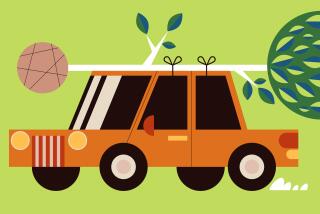L.A. County Arboretum’s fallen trees open a door to the future
The old tree trimming chief walked amid the stumps and shattered timber, taking stock of his “children.”
Ralph Gutierrez, 76, worked at the Los Angeles County Arboretum & Botanic Garden for nearly a quarter century, retiring in 1993. He climbed many of the trees himself as a trimmer and grew attached to the magnificent ones, the ones that gave him a thrill, like the 90-foot blue gum eucalyptus next to E.J. “Lucky” Baldwin’s cottage on the lake.
“We had an aerial lift that went up 30 feet,” he said as he surveyed the damage. “I still had 60 more feet to climb.”
The first thing Gutierrez asked when he arrived Monday was whether the eucalyptus — about 140 years old and one of the first arrivals of the Australian tree now ubiquitous in California — survived the windstorm last week.
It did.
But so many did not.
The rolling gardens, with duck ponds and glades set among lush stands of trees from around the world, lay in a jagged, splintery mess. Trunks had snapped in half. Boughs as heavy as cars sheered off like bird wishbones. A spiny gray brush of dead branches and leaves covered the once-pristinely manicured grounds.
The wind that laid waste to many of the region’s stateliest trees struck at its arboreal heart in Arcadia. Hundreds of trees were severely damaged or destroyed, altering the very landscape of one of the country’s largest botanical gardens, a living museum that is home to more than 10,000 types of plants.
Botanists began an inventory of the boot-shaped property, about a mile long from top to toe, to see how many of its trees were lost when the Santa Ana winds howled out of the San Gabriel Mountains last Wednesday night. Arboretum executives were already planning to launch the “largest tree planting campaign” since the park’s founding.
“To the people who know the arboretum, the landscape has been reshaped,” said Richard Schulhof, chief executive officer of the arboretum and botanical garden.
He pointed to a stand of giant birds of paradise lying flat on the ground.
“Look at this, it looks like South Florida a few years back after a hurricane.”
But even as he lamented the widespread loss of plant life, he was brimming with enthusiasm over new opportunities.
“This is the moment we envision the future of the tree collection.”
He said some sections of the 127-acre garden would be replanted as they were but that others, notably the section of Australian plants, would be reconfigured to focus more on environmentally sound landscaping and to showcase “the best plants for our region and community.”
“A big part of our future will be showing how people can create landscaping in harmony with Southern California.”
An immense amount of work lies ahead.
Broken limbs still hung perilously in the shredded canopy. Staff had not even reached some spots. One horticultural supervisor joked with Schulhof that the debris was so thick “it was like walking through chaparral.”
But L.A. County brush clearance crews and arboretum staff were making steady progress with chain saws. All of the debris will be shredded into mulch and returned to the soil on-site.
Schulhof said he expects it to take a week or two to remove hazards and clear enough debris to open a small part of the park near the entrance. The rest may remain closed for many more weeks.
The Australia section at the north end of the park took the brunt of the damage. Superintendent Timothy Phillips said 40 trees were destroyed in a 10-acre parcel. The fig collection and prehistoric forest were also hard hit. Staffers came up with a rough estimate on Monday that 300 trees were destroyed, but they had closely assessed only 35 acres and had barely begun to look at smaller plants buried in debris.
Some areas were less affected. A spectacular grove of Engelmann oaks growing down a south-facing slope survived with little damage. Gangly Mexican fan palms craning nearly 150 feet into the sky just bowed with the wind and endured.
Big elephantine ficus stayed stiff, then snapped.
“We were lucky in one sense that the ground was dry. If we had heavy rains and wet ground, a lot more trees would have toppled,” Schulhof said.
“One of the fascinating questions is how trees recover from this. We’ll be seeing all types of regeneration.”
The arboretum was founded in 1947 on the site of the late Baldwin’s homestead next to the Santa Anita Park racetrack.
“The initial vision was a collection of trees that would help beautify Los Angeles, trees that could be recommended to the nursery industry to grow in this climate,” Schulhof said.
“So much of what we have today was largely shaped by generations before.”
He said the new planting would focus more on education, noting that 15,000 students come through the arboretum every year. Last winter and spring, after various community meetings and surveys, the arboretum board developed a strategic plan that focused more on using plants suitable for the climate, whether they be native or from similar Mediterranean climates. One feature would be a new garden for growing food in “urban landscapes.” Another would show alternatives to water guzzling lawns.
Now there is more room to implement the plan.
“These new open spaces are great opportunities for planting,” Phillips said. “We can really enhance our collections.”
The arboretum, which is funded by L.A. County and its own foundation, launched an effort on its website, arborterum.org, to raise funds to replant the trees.
More to Read
Sign up for Essential California
The most important California stories and recommendations in your inbox every morning.
You may occasionally receive promotional content from the Los Angeles Times.











